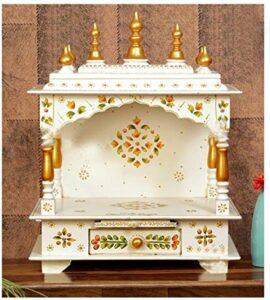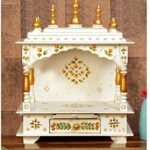A Guide to Vastu for Your Home Temple
The home temple, a dedicated space for worship and spiritual connection, holds immense significance in many cultures. Vastu Shastra, the ancient Indian system of design principles, offers valuable guidance for creating a harmonious and auspicious home temple that fosters devotion and inner peace. By incorporating these Vastu principles, you can transform your temple into a sacred sanctuary that uplifts your spirit and invites positive energy.
Finding the Divine Abode: The Ideal Location for Your Temple
The placement of your home temple plays a crucial role in its effectiveness. Here’s Vastu’s perspective on the ideal location:
The Zone of Purity: The Northeast Corner: According to Vastu, the northeast corner of your house is the most sacred and auspicious zone. This zone, governed by Lord Ishana, represents peace, spirituality, and knowledge. Placing your temple in this corner allows you to benefit from this positive energy while offering prayers.
Alternatives: If the northeast corner is unavailable, consider the east or north zone. These directions are also associated with positive energy and are suitable alternatives for your home temple.
Facing the Divine: Aligning with Positive Energy Flow
The direction you face while praying is important in Vastu:
Facing East or North-East: These directions are believed to enhance spiritual connection and focus during worship. Facing east allows you to greet the rising sun, symbolizing a fresh start and new beginnings, while facing northeast aligns you with the zone of purity and knowledge.
Avoid Facing South: The south direction is associated with fire energy, which can be disruptive and lead to restlessness. Avoid facing south while offering prayers.
Designing the Divine Abode: Creating a Sacred Space
The design and layout of your home temple influence the overall atmosphere:
Shape and Size: Opt for a small, square or rectangular-shaped space for your temple. Avoid using irregular shapes, which can create disharmony.
Flooring and Walls: Use light and calming colors like white, cream, or light yellow for the walls. Opt for marble or granite flooring, which are considered auspicious in Vastu.
Ventilation and Lighting: Ensure proper ventilation in your temple to allow for the flow of fresh air. Utilize natural light whenever possible. Consider adding small windows for additional ventilation and a warm glow.
Idol Placement: The main deity you worship should be placed on a raised platform facing east or north-east. Ensure the idols are properly secured and well-maintained.
Maintaining Harmony: Creating a Sanctuary for the Divine
A well-maintained and peaceful temple allows for uninterrupted devotion:
Cleanliness: Regularly clean your temple and keep it free from clutter. This promotes a sense of purity and invites positive energy.
Offerings and Lighting: Light a diya or oil lamp daily and offer fresh flowers and fruits to your deities. These offerings symbolize respect and devotion.
Peaceful Ambiance: Maintain a serene atmosphere in your temple. Avoid loud noises or distractions that disrupt your prayers.
Beyond the Walls: Creating a Spiritual Aura
Vastu extends beyond the physical layout of your temple:
Positive Thoughts: Approach your temple with a positive and reverent mindset. Let your prayers be filled with gratitude and good intentions.
Mantras and Chanting: Regularly chant mantras or recite prayers in your temple. The sound vibrations are believed to create a positive and uplifting spiritual aura.
Regular Practice: Make visiting your temple a regular practice. Even a few minutes of daily prayer can bring peace and focus to your life.
Remember: Vastu Shastra is a guide, not a rigid set of rules. The most important aspect is creating a space that inspires your devotion and fosters a connection with the divine. Customize your temple to reflect your personal beliefs and preferences. By combining Vastu principles with genuine faith and reverence, you can transform your home temple into a sacred sanctuary that nourishes your spirit and uplifts your life.


Industrial Vastu: Enhancing Productivity and Prosperity in Your Factory

Vastu Directions: Unlocking the Secrets to Prosperity in Vastu Shastra




